A new clinical study examined acupuncture for treatment of chronic rhinitis. Rhinitis is nasal congestion usually accompanied with post-nasal drip. There is irritation and inflammation of nasal tissue. In western medicine, this is ascribed to a viral or bacterial infection (or other antigen such as pollen) that stimulates mucus production. The study examined a test group of 85 patients and notes that chronic rhinitis is due to wind-cold or wind-heat obstructing lung Qi. These perspectives, both from Chinese medicine and allopathic medicine, are reconcilable in that wind-cold and wind-heat typically involve either a microbial infection or another antigen-antibody response.
If untreated, chronic rhinitis can last many years. Rhinitis can involve many complicated patterns such as epistaxis (nose bleeding), thick yellow or profuse white phlegm in the sinus and throat, coughing, insomnia, unclear thinking, difficulties with olfaction, dyspnea, asthma, and many other clinical complications.
Acupuncture Effective Rate
This recent clinical study had an effective rate of 96.5 percent with 61 persons obtaining total recovery, 21 with marked improvement, and 3 with no effect. To achieve the standard of total recovery, the resolution of all of the patient’s symptoms required resolution. Rhinoscopy and absence of symptomology was used to confirm the results. A two year follow-up confirmed total recovery. At a rate of one treatment per day, fifteen acupuncture sessions consisted of one course of treatment. The 96.5 percent effective rate was achieved after two courses of treatment (30 acupuncture appointments) unless total recovery was achieved prior to completion of the second course of acupuncture treatment.
Acupuncture Treatment Protocol
The needles were 0.35 mm (28 guage) in diameter and 40-50 mm in length. The acupuncture points chosen were: GB20 (Fengchi), LI4 (Hegu), and St36 (Zusanli). Supplementary acupuncture points were UB12 (Fengmen), UB13 (Feishu), Yintang (Ex-HN 3), and Du14 (Dazhui). Supplementary acupuncture points were chosen dependent upon differential diagnostics. In many cases, 20 minutes of manual needle manipulation were applied at each acupuncture visit. Tonification and reduction acupuncture needle techniques and moxa were chosen dependent upon excess, deficient, heat, and cold diagnostics.
Etiology and Analysis of the Study
In one analysis, the initial response to the pathogenic attack begins to linger as a residual pathogenic influence that never fully clears from the bodily system. In western medicine, a pathogen lodges in the body and stimulates the inflammatory chemicals of the complement cascade. In Chinese medicine, chronic rhinitis usually begins as a Wei or Qi level attack (Wen Bing, 4 levels) or a Tai Yang Shan Han, Tai Yang Zhong Feng, Tai Yang Su Xue, or Tai Yang Su Shui attack (six stages of cold induced illness). The lung Qi becomes compromised and the bodily system may develop a complex of excess and deficient patterns lodging in the Taiyin and Yangming acupuncture channels.
There is no inconsistency with the modern medicine view that a microbial pathogen or other antigen is the cause of the chronic rhinitis. An antigen is sufficient to cause chronic rhinitis, however, other factors may initiate the inflammatory response absent invasive antigens. Therefore, antigens are not necessary to initiate rhinitis. In that sense, allopathic medicine measures some, but not all, of the etiological factors contributing to chronic rhinitis. In Chinese medicine, the overall physiological strength of the lungs and the pathways leading to the nasal system are equally as important as the immunological responses to antigens. Further, environmental conditions such as dryness, heat, dampness, coldness, etc… are important factors. Moreover, dietary and emotional factors play important roles in balancing the respiratory pathways.
Reference: An Hua, Qinhuangdao Port Hospital, Hebei, China. "Treatment of 85 Cases with Chronic Rhinitis by Acupuncture." J. Acupunct. Tuina. Sci. 2010, 8 (5): 318.


